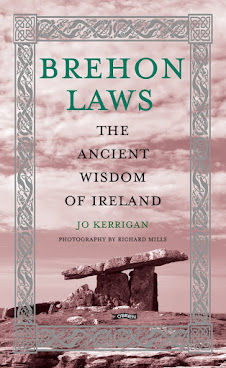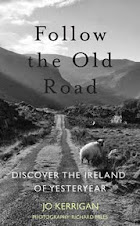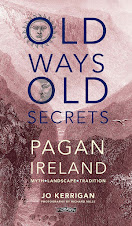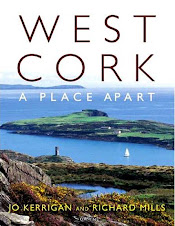What a joy to see May Day. This was one of those long and dreary winters, with the tardy spring delaying its growth as long as possible, but at last the trees are in fresh green leaf, and the white lilac is coming into full scented bloom.
Something else has come into bloom, our latest book!
All The Way by the Grand Canal is published by O'Brien Press on Monday next, May 8, and will be in all the bookshops then. It can also be purchased online from O'Brien Press.
We had a lot of fun researching this new child of ours, spending a great deal of time crossing the midlands of Ireland from east to west, from Dublin to the Shannon, and discovering quite a lot of places we hadn't known anything about before.
Like the utterly gorgeous little hamlet of Belmont where the lock and the cottages and all the old buildings around combined to make it the most peaceful place possible. Really fascinating were the round indentations in the sides of the lock, which were where the bargemen would insert their poles to guide the boat along. Remember the phrase 'wouldn't touch it with a barge pole'? Well, the canals are where that saying originated, and here they really did touch the walls, and push hard too - they had to, since the horse would have been untackled and walked on to the other side of the lock, leaving them with no other means of propulsion..
The book is two things really: a guide to anyone wanting to walk or cycle this wonderful long greenway from our capital city right across the Bog of Allen to the mighty Shannon, but also a history of how it came to be, who built it, what stories and incidents happened along it, and all sorts of fascinating facts that you find when you are researching something right out there in the field. So as well as being ideal for the strolller with the family, the keen hiker, and the ardent cyclist, it's perfect armchair reading too for anyone who wants to know more about hidden Ireland and its history.
Look at the splendour of White's Castle and Crom-a-Boo Bridge (great name, isn't it?) in Athy. That was where the Barrow Line branch separated from the main Grand Canal and headed south to join up with the river Barrow and thus connect Dublin efficiently with the port of Waterford. Remember, all this was before railways were thought of, let alone roads and cars, so the canals had a vital purpose for conveying goods and people. Guinness even had its own barges plying the canal from Dublin to thirsty purchasers in other towns and cities. They always claimed that the slow peaceful carriage by boat added a certain je ne sais quoi to the barrels!
We are fairly proud of this, our sixth offspring, Richard and I. But of course it didn't take long to start wondering where we should explore next. Somewhere mystic and mysterious, with a few ghosts and goblins and unexplained occurrences maybe? A haunted island, perhaps? Will keep you posted.
Last weekend, having finally relaxed on the book (there are always last-minute changes, alterations, queries) we headed over to Wales on the ferry. Richard wanted to get a few new shots of red kites, and I wanted to indulge my yarn habit at Wonderwool Wales, a huge annual occasion in Builth Wells where sheep farmers and spinners, knitters and crocheters, buyers and sellers of all kinds converge for a weekend of fun.
Look at this splendid felted March Hare being wheeled proudly around by its creator! She had lost the use of one arm through illness and got it back to full working order by making this amazing project! I didn't get her name, but well done you!
I am always on the lookout for Norwegian yarns, and found a stall which stocked them.
Yes, quite a few skeins and balls found their way into my ample shopping bag at SKD Yarns!
Got to meet in person at last one of the great exponents of the traditional knitted gansey, Deb Gillanders of Propagansey.
Had a special meet up with an old friend, Linda, so that we could compare spindles and spinning skills. And Linda of course had pre-ordered her copy of the new book so we were able to hand it over, duly signed by both of us.
The crowds at Wonderwool Wales were frightening, but everybody was so happy and enthusiastic and willing to share ideas and notes that it was all very relaxed. Except for the endless queues for coffee. It has to be admitted that the modern trend for 'slow' specially prepared brews is admirable, but it does make for a long waiting time. In the end we did without.
I think this picture says it all about the long and happy weekend - one tired but contented spinner heading for home.
As did we, breaking our journey in Carmarthen on the way back. Where we saw a dog taking his ease and enjoying the street scene.
You might be wondering how our own new little monster has been getting on since last time. Well, she has grown a bit, is happy, healthy, very loving and quite biddable - until she gets on to a beach,. Then you can say goodbye to Tasha for the rest of the day. Or until she tires out, which so far appears to be never.
There was a traumatic experience on the beach at Ballycotton a month or so back. Tasha exploded down the sands, saw gulls in the distance, and hared way out along a wave-washed sandback to catch them. They of course flew off, cackling with laughter, and she paused briefly to reconsider her options. Seeing me strolling along the beach some distance on, with the older dog, she decided to cut across to intercept us. What she didn't realise was that a rather large section of wave-tossed sea lay between.
That small black head is scarcely visible here, so Richard has kindly circled it in red. I was frantically watching through binoculars and so could see the brief moment of shock as she found herself well out of her depth, and then the almosts visible shrug of canine shoulders as she coped with a completely new exercise - swimming. She had not, up to this, come across deep water. Or anything other than shallow pools, come to that.
The wind was strong, and blowing offshore, towards her. I could see her trying to make headway and achieving very little. I cupped my hands and shouted encouragement. Then she seemed to set her teeth and try harder. Slowly, slowly she started to move against the wind, towards the shore.
Here she is, gradually nearing the shore, but still in quite deep rough water. On the right of the picture there you can see Troushka anxiously paddling out as far as she dares, to guide her in.
And she was out, on dry sandy land at last, soaked through, panting a little, but rather pleased with herself. She lay down and rolled in dry sand vigorously and then chased off to see what other adventures she could find.
I should perhaps explain that Richard was some distance away on a sand dune with a long lens, looking for rare gulls. He was thus able to capture the frightening event, albeit at long range.
I know, I know, you will say any puppy can swim automatically, it's no big thing. But Tasha had never been in for anything but a paddle before, and though she looks quite big in that final picture, she is still a fairly small little spaniel. And the offshore wind and the waves were pretty strong that day. Well, at least now I know she can swim the Channel! But my heart was beating fast at the time, I can tell you.
Now it is time to enjoy the start of summer. Wherever you are, mark this day - one trusts that you did go out at dawn to wash your face in the dew, but if you didn't, there is still time, up to midnight. Bealtaine, Beltane, one of the two great Celtic festivals from the beginning of time (the other of course being Samhain, which leads into winter).
Later came divisions like Imbolc in February, Midsummer, Lunasa in August, and Midwinter, but these two were the principal festivals in ancient times separating the two halves of the year, and were marked by celebrations, feasting, and ritual, including the magic fire, kindled by the senior druid from nine special woods. All other fires had to be extinguished before this, and then rekindled from the sacred flame.
Remember that back then, fire was essential for survival, and most households kept the blaze going from one end of the year to the other. Extinguishing it for these two festivals was a serious matter (no, they didn't have safety matches, nor yet gas lighters.) Once all house hearths had been rekindled, and the sacred fire had burned down, the ashes were spread on the fields to encourage fertility. Parents would mark young children's clothes with an ashy cross to stop the fairies stealing them away.
Maybe you should light a fire tonight too? Throw on a few herbs if you do. It's a good way of keeping in touch with the old beliefs.































